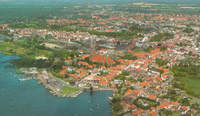|
The history of the city of Schleswig |
|
The modern town of Schleswig was founded in 1711, when its constituent parts were formally united. Schleswig consists of the medieval town centre, the fishermans village on the Holm and the more recent district Lollfu and Friedrichsberg, where the noblemen, the civil servants and the soldiers of the dukes of Schleswig erected their Homes in the 16th century. The origins of the medievel centre, however, date back much further than that. Excavations near the ancient market-place have shown that Schleswig is at least as old as the Viking town of Haithabu, the famous place on the Haddeby Noor Right oppsite Schleswig. During the 9th and 10th centuries Haithabu was the most important trading centre in the whole of northern Europé. This was due to its geographical position between the North Sea and the Baltic right in the centre of maritime trade between Skandinavien and Russia on the one side and England and continental Europé on the other. Here Anglo-Saxon and Dutch merchants met with Vikings from Iceland, Norway and Denmark as well as the Swedish "Waräger" from Birka in the Mälaren who used to go down the Dnjepr and the Wolga as far as Constantinople and the Caspian Sea. In 1066 Haithabu was attacked by an armed force af Slavs. It was burnt down never to be built up again. The Survivors of the catastrophy possibly moved to the northern shore of the Schlei: to Schleswig. This town, which is referred to as "Sliasthorp" or " Sliaswhich as early as 804 in contemporary chronicels was made a bishop`s seat by the German king Otto I. In 948. Remnants of the foundations of a big cathedral were found underneath the choir of today`s church, St. Peter`s, which is a famous landmark in the slightly undulating country along the Schlei. Schleswig remained an important trading centre until it was finally superseded by Lübeck . The shallow waters of the Schlei were not deep enough for the new type of vessel used by the merchants: the "Kogge". So Schleswig gradually lost its importance as a seaport and became a rather quiet centre of rural trade. As most medieval towns Schleswig was originally surrounded by a wall. Apart from the cathedral there were at least seven other churches or monasteries inside the walls, most of which have completely disappeared. Of the walls and towers nothing is left. While Schleswig´s importance as a centre of trade was dimishing, the town got a new function at the end of the middle ages, when the dukes od Schleswig made Gottorf, the old bishop´s palace, their permanent recidence. When this castle became the property ofDanish kings in 1459, Gottrof gradually developed to be a rather stately place, which in due course, attracted a considerable number of noblemen and civil servants who built their more or less stately homes next to the simple houses and hovels of workmen and soldiers on either side of the castle. When two innocent women were brought to trial and burnt as witches in Schleswig in 1551, it became obvious that a time of gigotry, religous superstition and intolerance had begun. In the following period of conflicts between Catholics and Protestants Schleswig had to suffer a lot. During the tribulations of the 30-year-war the town was occupied by Wallenstein and the Swedes servial times, which meant a sad decline in wealth and prosperity for the citizens. Thougt there was a successful attempt at manufacturing faience ( a kind of pottery) , Schleswig has never been an industrial town , but in the 19th century it became a centre of resistance against the Danish monarchy and its efforts to make the duchy of Schleswig a constiuent part of Denmark, which it had practially been until 1848. Uwe-Jens Lornsen, whose name was given to one of the town`s two grammar schools, played a very important part in Schleswig-Holsteins struggle for freedom and indepence. It was in the town-hall of Schleswig where decisive steps towards an independent German government were taken by the representatives of the German popularition. When the northernmost part of Germany was eventually incorprated into Russia after 1864, Schleswig was made the capital of the new province and kept this funcion until the end of the second world war. Schleswig now Isn`t the seat of the government any longer. But even today the old town on the Schlei, With its majestic cathedral and its famous castle ( which really is a big museum ) can still be consiered the secret capital of Schleswig - Holstein. This small minority of Danes who have remained south of the broder even after the ancient duchy of Schleswig was divided between Denmark and Germeny after World war 1, is guaranteed the same civil rights as the German majority. The Danes have their own shools, library, newspaper and clubs and loyal citizens who generrally can speak boht Danish andGerman. Schlieswig has got town partnershis with Mantes-la-Jolies in France and Hilligodon in England, the Kreis Schleswig-Flenesburg is connecting with the borough of Shouht Ribble in Lancashes and the Protestant church of Shleswig has estanblished a close relationship to the churches in the area of pärnu in Estonia. Thus the citizens of Schleswig have shown how much they appreciate frendship and cooperation with other municipal centes in Europ. |
[Back to the previous page]
